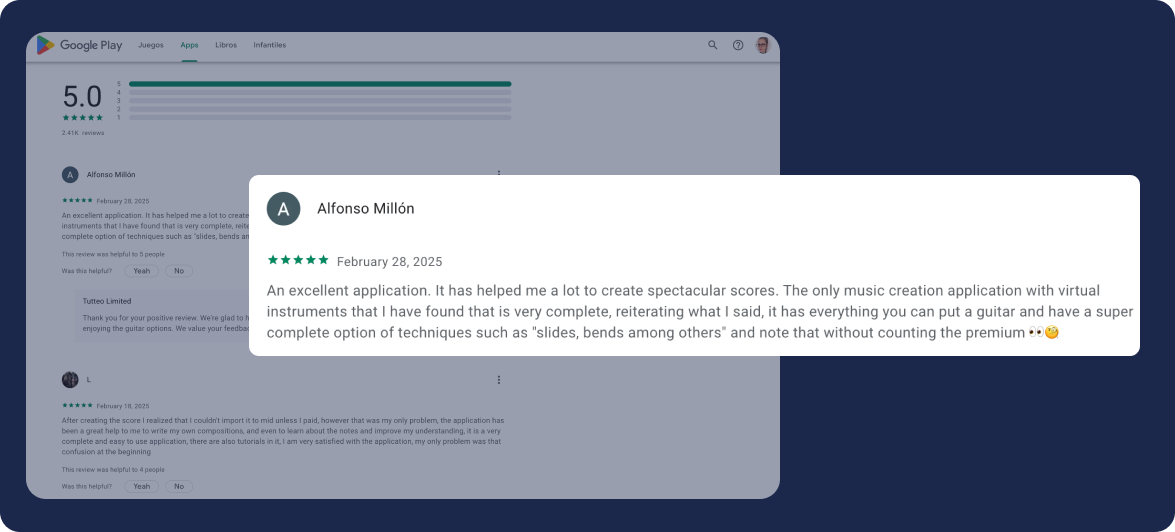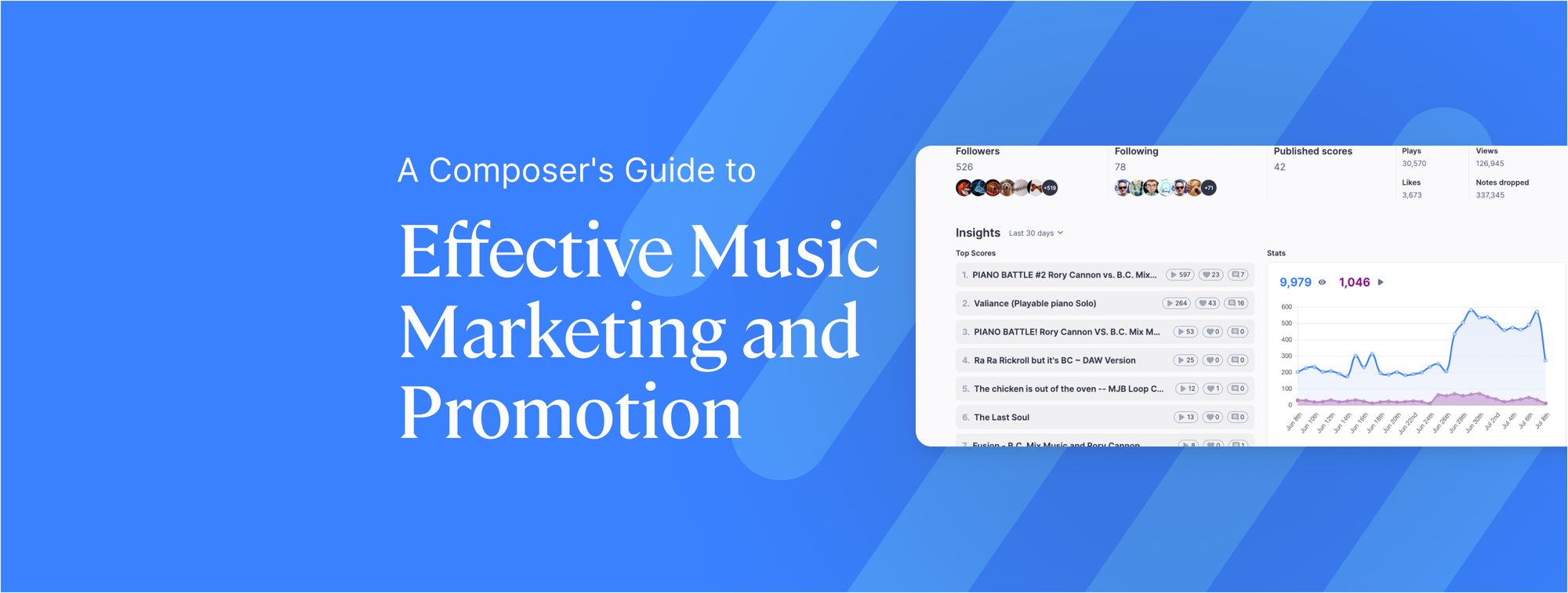The digital era has transformed how we create and share music. Creative processes are faster, expectations are higher, and for today’s musicians, adaptability is essential.
With so much of our work happening on the go, phones and tablets have become indispensable creative tools — portable, accessible, and always within reach. Mobile composition isn’t just convenient; it’s often necessary.
Whether you're sketching melodies during your commute or refining harmonies from the sofa, the right sheet music maker can turn fleeting ideas into finished pieces. But with so many apps out there, how do you know which one truly fits your workflow?
In this guide, we’ll walk you through the key features, usability considerations, and collaboration tools to look for when choosing a music writing app for Android or iPad.

Must-Have Features in a Mobile Sheet Music Maker
The best app for you depends on your specific needs, so I recommend taking a moment to list the must-have features you can't go without, as well as the nice-to-haves you'd like if available. Having this list as a reference will make it much easier to compare options later.
That said, there are a few core essentials every good sheet music app should offer. Let’s take a look at what you should keep in mind to make a smart choice.
Mobile-Native Design
Not all notation software is designed with mobile use in mind. It's important to choose an app that was built specifically for mobile devices — otherwise, you may run into limitations, clunky navigation, or a poor user experience that leads to frustration and a steeper learning curve.
A well-designed mobile app should prioritize ease of use and core functionality over unnecessary complexity, helping you stay focused on creating, not troubleshooting.

A good way to find out if this applies to the sheet music maker you're considering is to check the reviews in the App Store or Play Store.
Complete and Intuitive Notation Suite
Beyond being mobile-friendly, the app should offer an intuitive notation interface that makes composing feel smooth and direct. This doesn’t mean fewer features—it means smarter design that puts essential tools within reach without overwhelming the screen.
Here are the core notation features to look for:
- Easy note input and editing – Build and adjust your composition with minimal friction.
- Key and time signature customization – Set up tonality and rhythm to match your musical vision.
- Dynamics and articulations – Add expressive detail and clarity.
- Transposition tools – Adapt your music across different instruments or ranges.
- Instant playback – Listen to your work as you go and make quick refinements.
- Instrument selection – Having the option to choose from a wide variety of sounds for different setups.
🎧 Playback with Realistic Sounds
Real-time playback is essential when you're composing on the go—it lets you quickly check your work, hear how ideas are coming together, and make adjustments on the spot. While mobile playback can’t yet match the depth of desktop VSTs, having high-quality sound libraries still makes a big difference, especially when you’re sharing your compositions with others.
Good playback helps others understand your score without needing to read the sheet music. For example, in Flat, we offer HQ instruments—real instruments professionally recorded in a studio—so your compositions sound polished and expressive straight from your device.
🎹 MIDI Input & Editing
Composing on mobile devices comes with some challenges, especially when it comes to screen size and input limitations. That’s why it’s important to choose an app that includes a virtual piano and supports external MIDI keyboard input for writing your scores. These features can make the composition process faster and far more accurate, especially when working on complex pieces.
Some apps even allow real-time MIDI recording, automatically converting your performance into music notation — so all you need to focus on is playing, and the app takes care of writing the score for you.
📶 Offline vs. Cloud Access
When composing on mobile, maintaining a smooth and uninterrupted workflow is required. That’s why offline functionality is more than a convenience — it’s a necessity. An app that allows you to write and edit without an internet connection ensures that your creative process isn't interrupted by external conditions.
Equally important is cloud synchronization. Once you're back online, your progress should sync automatically without requiring manual steps.

If you're working in multiple locations or switching between devices, this combination — reliable offline use and automatic cloud sync — allows for a flexible, efficient workflow that supports your creativity instead of disrupting it.
Which brings us to the next point.
🔄 Cross-Device Compatibility
Cross-device compatibility is another important factor to consider. If you regularly switch between your phone, tablet, and desktop, your tools should transition with you. Look for apps that offer consistent functionality across platforms and sync your work through a single account. This ensures your compositions remain up to date and accessible, no matter where — or how — you're working.
With Flat, you can use a single account across all your devices, giving you the flexibility to compose anytime, anywhere — without losing continuity.

📨 Export and Sharing Capabilities
Once your composition is ready, being able to share it easily — and in the right format — is key. Look for apps that support the most common used formats, such as PDF, MIDI, and MusicXML. These options give you the flexibility to print your score, import it into other software, or collaborate across platforms without compatibility issues.
It’s also worth considering how the app handles direct sharing. Can you send someone a link to view or comment on your score? Do they need an account to access it? The smoother this process is, the easier it becomes to present your music, gather feedback, or distribute it to the right people. Some tools even allow you to embed scores directly on your website or portfolio — a simple yet powerful way to showcase your work professionally.

👥 Real-Time Collaboration
Music is a deeply personal creative process — but it’s also inherently collaborative. Whether you're sharing a new piece with your bandmates, exchanging ideas with a teacher, or reviewing a student's composition, collaboration plays a key role in growth and inspiration.
That’s why it’s worth choosing a composition app that offers real-time collaboration features. Being able to co-edit a score, give instant feedback, or build something together in the same space makes the creative process more dynamic, interactive, and enjoyable for everyone involved. It removes friction and turns collaboration into a natural part of your workflow — not an obstacle.

Common Mistakes to Avoid When Choosing a Sheet Music App
From my own experience, here are a few mistakes to steer clear of when making your choice:
- Choosing overly complex tools: Some apps mimic desktop DAWs but aren’t optimized for mobile use, which can slow you down.
- Ignoring update frequency: An app that isn’t actively maintained is more likely to have bugs or compatibility issues. Always check the update history in the Store.
- Not considering your workflow: Every musician works differently. Make sure the app supports your instrument and writing style.
- Skipping export tests: If you plan to continue your work elsewhere, verify that export formats (PDF, MIDI, MusicXML) work properly.
By avoiding these common missteps, you’ll set yourself up for a better composing experience — and stay in flow from the first note to the final bar. Good luck finding your sheet music maker!


